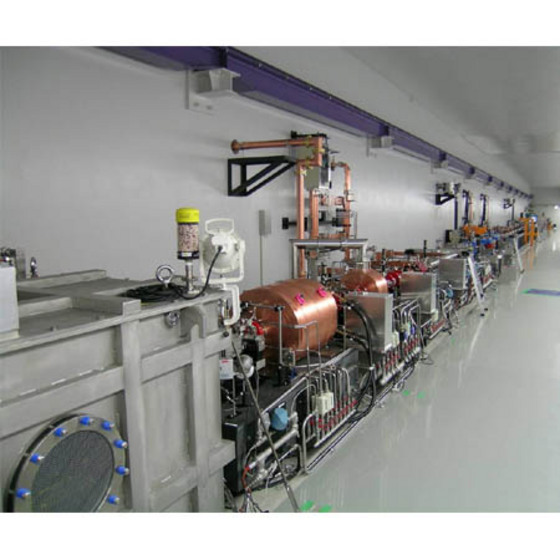Home > Press > Smaller, cheaper and better:A new design for compact free-electron lasers leads the way towards exploiting extremely short wavelengths
 |
| Figure 1: A view at the beam hall of the FEL test facility. The electron gun is contained in the grey box on the left. |
Abstract:
Physicists are greatly interested in free-electron lasers (FEL) because they are capable of generating high-intensity laser radiation across a very broad wavelength spectrum, even down to the extreme ultraviolet rays and x-rays. Worldwide, several multi-billion-dollar efforts are underway to build next-generation free-electron lasers at x-ray wavelengths. As part of these efforts, a compact and efficient design has been realized by researchers from the RIKEN XFEL Project Head Office, collaborating with the Japan Synchrotron Radiation Research Institute (JASRI). They report on the superior properties of extreme ultraviolet FEL laser radiation from a first-test system in Nature Photonics1.
Smaller, cheaper and better:A new design for compact free-electron lasers leads the way towards exploiting extremely short wavelengths
Japan | Posted on October 31st, 2008Free-electron lasers consist of two fundamental components: an accelerator that produces high-energy electrons, and so-called ‘undulators' that send these electrons on a periodically curved path. The wiggling of the electrons along the path causes the emission of high-energy laser radiation through electro-magnetic interaction between the electrons and the radiation field.
Currently, x-ray FELs require large-scale electron accelerators of a few kilometers in length. It is important to reduce this length to enable the fabrication of cheaper FEL systems. The project team's compact FEL design of 55 m has produced a high-quality laser beam at the RIKEN Harima Institute.
To achieve this significant reduction in accelerator length, the team used special undulators with a shorter electron oscillation period, which allows the generation of x-rays with lower energy electrons. However, for this novel scheme to work effectively, "a stable and high-quality electron beam is needed, where all electrons propagate nearly parallel and with high density," comments Hitoshi Tanaka from the team. To attain such good beam properties, the team used an ‘electron gun' (Fig. 1), technically known as a thermionic gun, which has a CeB6 single crystal cathode and is reminiscent of the electron emitters used in electron microscopes.
The full system presently being constructed next to the SPring-8 storage ring will reach a total length of about 700 m, which is less than a third of the length of competing designs. This shorter length reduces the construction cost, which is estimated at 370 billion yen, compared to 750 and 1,500 billion yen, respectively, for international competitors.
A future aim of the researchers is to also realize FELs at much shorter wavelengths, down to the x-ray region at around 0.1 nm, which will enable new research applications. Indeed, Makina Yabashi from the research team is convinced that this can be achieved and that "the compactness of our design will considerably expand the opportunities for engineering and medical research."
Reference
1. Shintake, T., Tanaka, H., Hara, T., Tanaka, T., Togawa, K., Yabashi, M., Otake, Y., Asano, Y., Bizen, T., Fukui, T. et al. A compact free-electron laser for generating coherent radiation in the extreme ultraviolet region. Nature Photonics 2, 555-559 (2008).
The corresponding authors for this highlight are based at the RIKEN XFEL Project Head Office
####
For more information, please click here
Copyright © Riken
If you have a comment, please Contact us.Issuers of news releases, not 7th Wave, Inc. or Nanotechnology Now, are solely responsible for the accuracy of the content.
| Related Links |
| Related News Press |
News and information
![]() Researchers develop molecular qubits that communicate at telecom frequencies October 3rd, 2025
Researchers develop molecular qubits that communicate at telecom frequencies October 3rd, 2025
![]() Next-generation quantum communication October 3rd, 2025
Next-generation quantum communication October 3rd, 2025
![]() "Nanoreactor" cage uses visible light for catalytic and ultra-selective cross-cycloadditions October 3rd, 2025
"Nanoreactor" cage uses visible light for catalytic and ultra-selective cross-cycloadditions October 3rd, 2025
Discoveries
![]() Researchers develop molecular qubits that communicate at telecom frequencies October 3rd, 2025
Researchers develop molecular qubits that communicate at telecom frequencies October 3rd, 2025
![]() Next-generation quantum communication October 3rd, 2025
Next-generation quantum communication October 3rd, 2025
![]() "Nanoreactor" cage uses visible light for catalytic and ultra-selective cross-cycloadditions October 3rd, 2025
"Nanoreactor" cage uses visible light for catalytic and ultra-selective cross-cycloadditions October 3rd, 2025
Announcements
![]() Rice membrane extracts lithium from brines with greater speed, less waste October 3rd, 2025
Rice membrane extracts lithium from brines with greater speed, less waste October 3rd, 2025
![]() Researchers develop molecular qubits that communicate at telecom frequencies October 3rd, 2025
Researchers develop molecular qubits that communicate at telecom frequencies October 3rd, 2025
![]() Next-generation quantum communication October 3rd, 2025
Next-generation quantum communication October 3rd, 2025
![]() "Nanoreactor" cage uses visible light for catalytic and ultra-selective cross-cycloadditions October 3rd, 2025
"Nanoreactor" cage uses visible light for catalytic and ultra-selective cross-cycloadditions October 3rd, 2025
Photonics/Optics/Lasers
![]() ICFO researchers overcome long-standing bottleneck in single photon detection with twisted 2D materials August 8th, 2025
ICFO researchers overcome long-standing bottleneck in single photon detection with twisted 2D materials August 8th, 2025
![]() Institute for Nanoscience hosts annual proposal planning meeting May 16th, 2025
Institute for Nanoscience hosts annual proposal planning meeting May 16th, 2025
|
|
||
|
|
||
| The latest news from around the world, FREE | ||
|
|
||
|
|
||
| Premium Products | ||
|
|
||
|
Only the news you want to read!
Learn More |
||
|
|
||
|
Full-service, expert consulting
Learn More |
||
|
|
||








